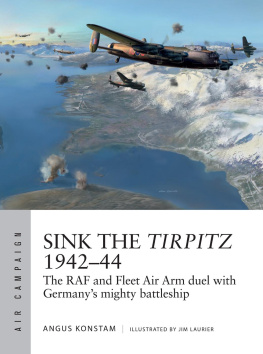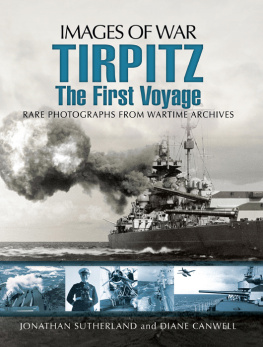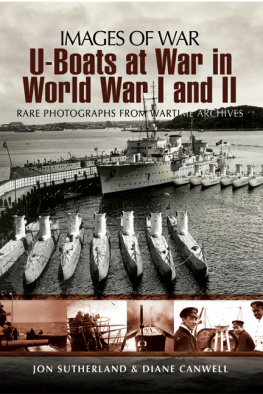
First published in Great Britain in 2011 by
PEN & SWORD MARITIME
an imprint of
Pen & Sword Books Ltd
47 Church Street
Barnsley
South Yorkshire
S70 2AS
Copyright Jon Sutherland and Diane Canwell 2011
ISBN 978 1 84884 668 5
eISBN 978 1 84468 898 2
PRC ISBN 978 1 84468 899 9
The right of Jon Sutherland and Diane Canwell to be identified as Authors of this Work has been asserted by them in accordance with the Copyright, Designs and Patents Act 1988.
A CIP catalogue record for this book is available from the British Library
All rights reserved. No part of this book may be reproduced or transmitted in any form or by any means, electronic or mechanical including photocopying, recording or by any information storage and retrieval system, without permission from the Publisher in writing.
Typeset in Gill Sans by
Phoenix Typesetting, Auldgirth, Dumfriesshire
Printed and bound in England by
MPG Books Group
Pen & Sword Books Ltd incorporates the Imprints of Pen & Sword Aviation, Pen & Sword Family History, Pen & Sword Maritime, Pen & Sword Military, Pen & Sword Discovery, Wharncliffe Local History, Wharncliffe True Crime, Wharncliffe Transport, Pen & Sword Select, Pen & Sword Military Classics, Leo Cooper, The Praetorian Press, Remember When, Seaforth Publishing and Frontline Publishing
For a complete list of Pen & Sword titles please contact
PEN & SWORD BOOKS LIMITED
47 Church Street, Barnsley, South Yorkshire, S70 2AS, England
E-mail:
Website: www.pen-and-sword.co.uk
Contents
Introduction
T he photographs in this book are from a single album that is believed to have been owned by Wilhelm Rosenbaum. Perhaps the pinnacle of his career service was a period that he spent onboard the Tirpitz, probably between April 1942 and March 1944. Rosenbaum was one of a few members of the Luftwaffe who served alongside the Kriegsmarine as crew for seaplanes on larger surface vessels.
The collection of photographs chronicles a period in the late 1930s when Rosenbaum completed his six-month Reichsarbeitdiensd (RAD or German national work service). He is thought to have undertaken this compulsory labour service between April and September 1937.
Rosenbaum would then be required to serve for a period of at least two years in one of the armed services. It is clear that he chose the Kriegsmarine as the next section of his album focuses on his cadet training aboard the masted sailing vessel, Horst Wessel. At this stage we assume that this was the first part of his training as an officer in the Kriegsmarine.
We also know that Rosenbaum then went on to serve briefly on the German armoured cruiser Schleswig Holstein between 1938 and 1939. At this point the vessel was commanded by Kapitan zur See Gustav Kieseritzky. A number of the photographs suggest that Rosenbaum was onboard for the vessel's trip to the Caribbean via Spain and Venezuela. This vessel had been part of the German High Seas Fleet in the First World War, but by the 1930s had been downgraded to a training vessel. It was imperative that all officer cadets had experience of serving on large surface vessels.
By the spring of 1942 Rosenbaum had become an observer and part of a two man crew of an Arado 196 seaplane, aboard the Tirpitz. He was part of the bordfliegergruppe (shipboard reconnaissance squadron). It was fortunate for Rosenbaum that he was probably not aboard and had been transferred; possibly to northern Italy by the time the Tirpitz finally succumbed to repeated attempts by the RAF to sink her off Norway. The collection contains a set of photographs that seem to suggest that Rosenbaum served for a period in the Mediterranean.
It is not entirely clear exactly what became of Rosenbaum directly after his service on the Tirpitz. Certain parts of the unit to which he was attached did serve in the Mediterranean, whilst others found themselves on the French Atlantic coast.
The final batch of photographs shows him as a prisoner of war in the former Stalagluft 203 in Mulsanne, just offthe national road from Paris to Tour. The camp, close to Le Mans, had been taken over by the allies and was guarded by Moroccans under American command and later by the French. It was to become the largest camp for German officers in France. We do know that this prisoner of war camp served as a collection point, initially for German servicemen that had been cut off from the German retreat east after the breakout from Normandy. It is quite probable that Rosenbaum was in fact attached to a land-based reconnaissance and observation flight, possibly at Brest. This would tie in with his presence at this prisoner of war camp in France.
Unfortunately it is unclear what became of Rosenbaum. We do know that he celebrated his birthday in August 1947 as a prisoner of war. By that time many of the German officers had been sent on to labour camps and the Mulsanne camp was being broken down and dismantled.
Of particular interest amongst the fascinating photographs in this collection are those of the U-23, which saw extensive service throughout the war. Rare photographs of the crew and Arado aircraft based on the Tirpitz are also included, as well as photographs of a number of highly decorated German U-boat commanders that were also in the same prisoner of war camp as Rosenbaum.
We are indebted to the owner of this album, James Payne, for his permission to use them in this photographic record of one of the few Luftwaffe aviators to serve onboard the iconic Tirpitz.
The Tirpitz never quite lived up to the reputation of its sister ship, the Bismarck. Tirpitz was actually the largest battleship ever built in Europe, as she was bigger than the Bismarck. Tirpitz spent most of the war in German occupied Norway. The Norwegians called her The Lonely Queen of the North. Winston Churchill was less flattering and dubbed her The Beast.
By the time Tirpitz finally succumbed to another determined Lancaster bomber attack on November 12 1944 Rosenbaum had left the vessel and was fortunate not to be one of the 971 crewmen to lose their lives when she capsized to the west of Tromso.
CHAPTER ONE
THE RAD SERVICE (Reichsarbeitdienst)
I n the aftermath of the First World War and into the 1920s and early 1930s Germany suffered from severe economic problems and high unemployment. As early as the 1920s there was a great problem with what to do with the hundreds of thousands of ex-servicemen who found it impossible to find work. Political groups, civic authorities and even the church set up a range of independent work camps all across Germany to provide employment. Many of the men were employed to carry out agricultural work or to supply essential labour for civic projects.
On June 5 1931 the then German chancellor, Brning, called for the creation of a national work service, or voluntary labour service (Freiwilliger Arbeitsdienst)(FAD). Even at this early stage the Nationalsozialistische Deutsche Arbeiterpartei (NSDAP), or later to become the Nazi Party, had set up their own camps. The national work service project was headed up by Konstantin Hierl. He would later become a major figure in Nazi Germany. He was not only the head of the FAD but was also a member of the NSDAP. When the Nazi Party came to power in 1933 Hierl became State Secretary for Labour Service, a part of the Reich Labour Ministry. The FAD was then renamed Nationalsozialist Arbeitdienst or NSAD. It was then renamed in July 1934 as the
Next page












